Industrial Organization: characteristics and contents Marc Escrihuela

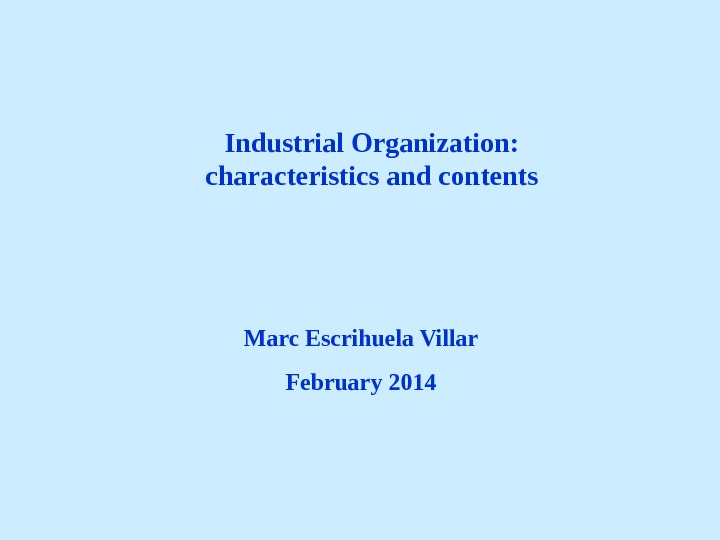
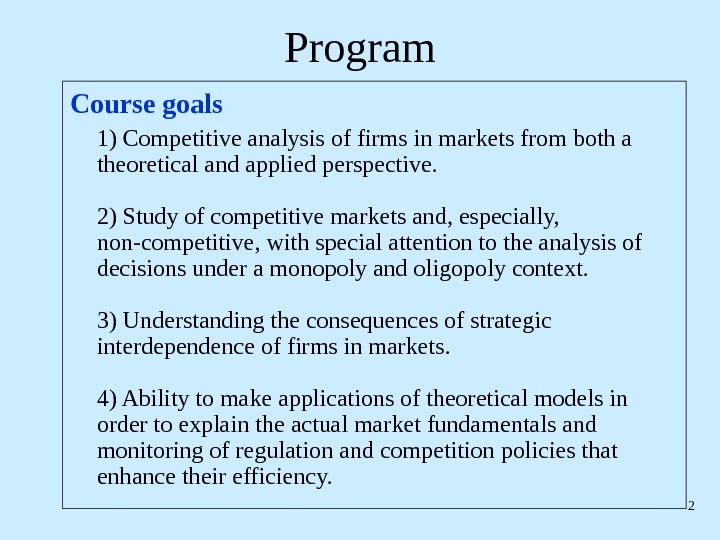
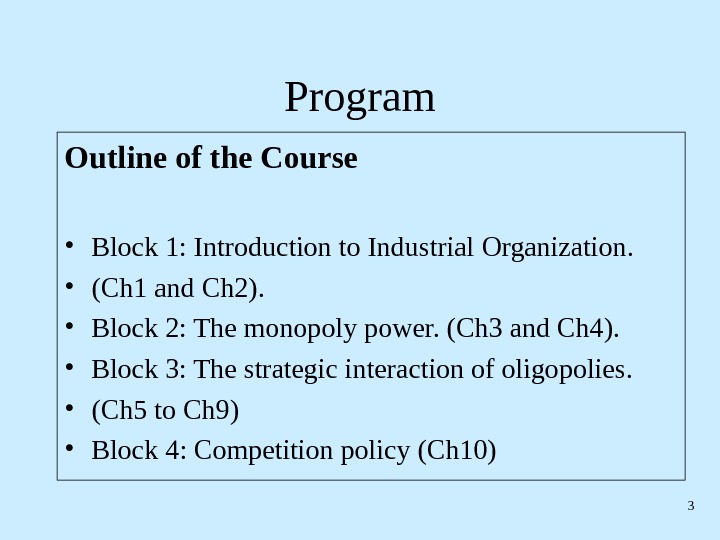
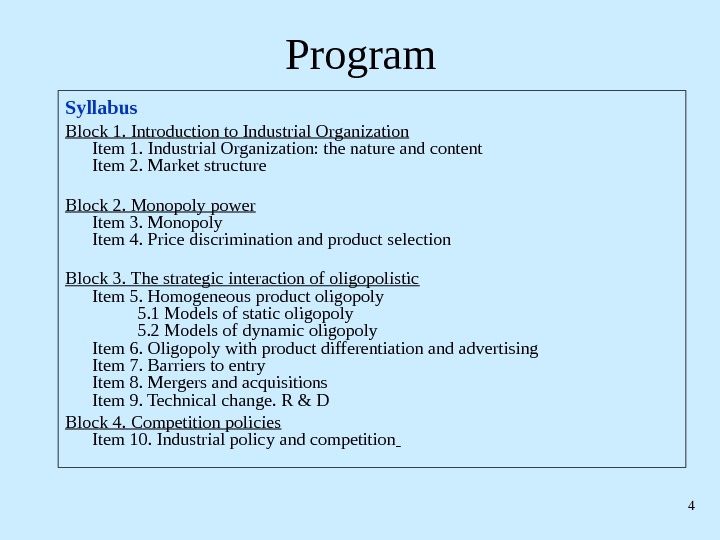
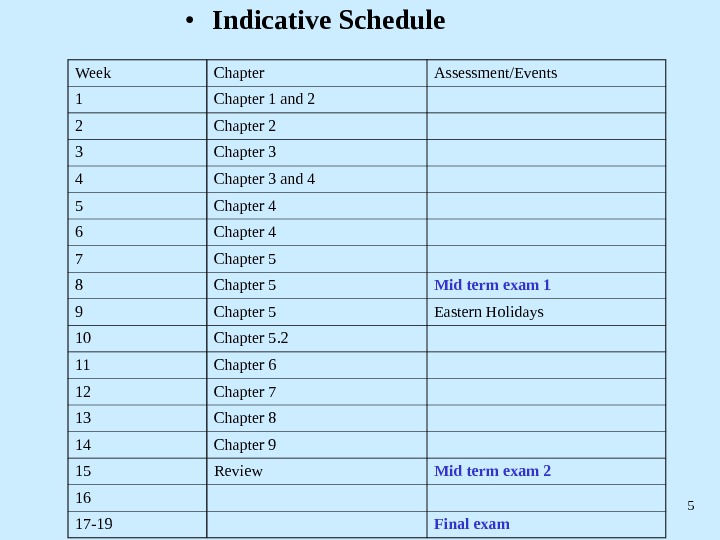
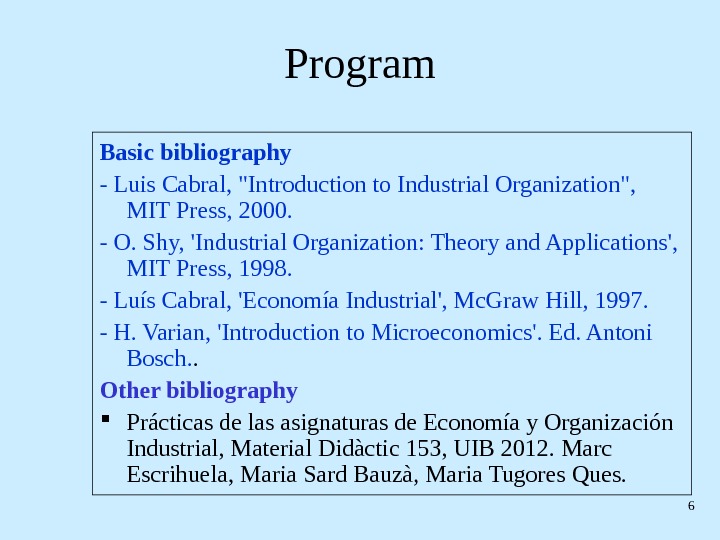
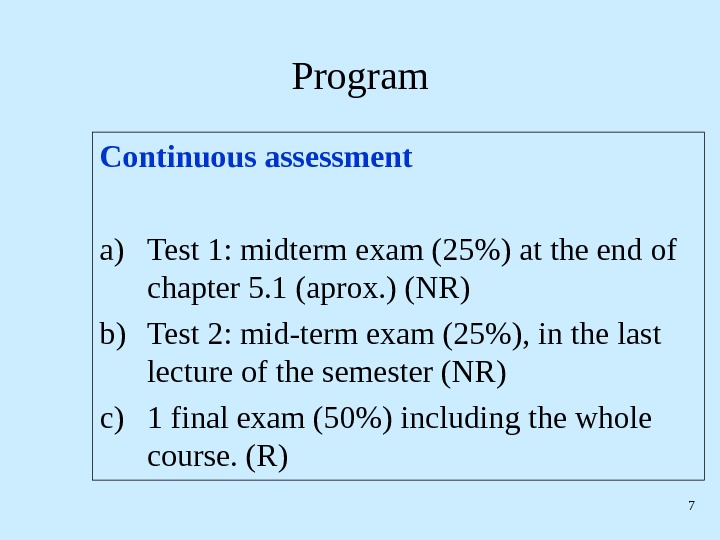
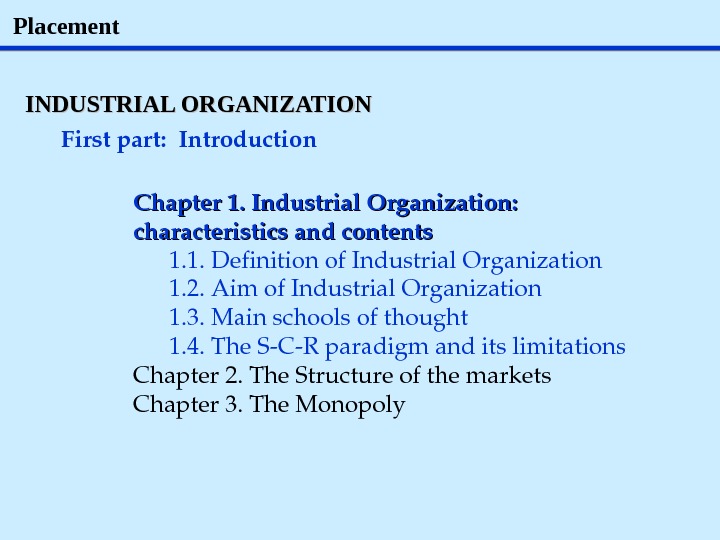
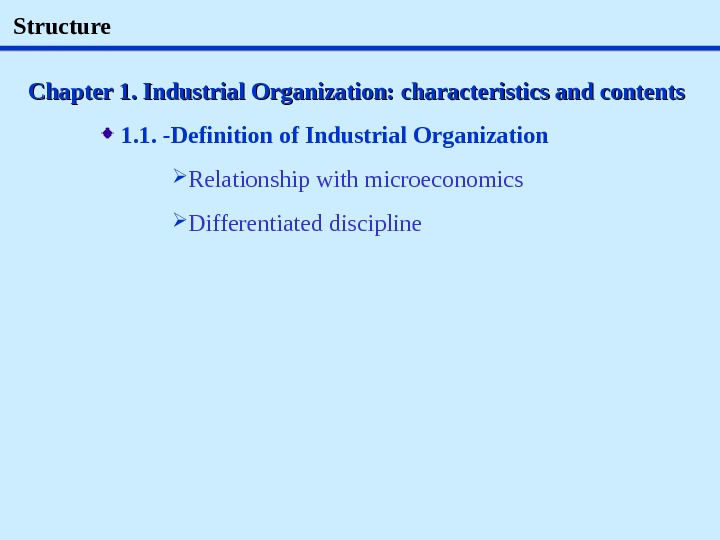
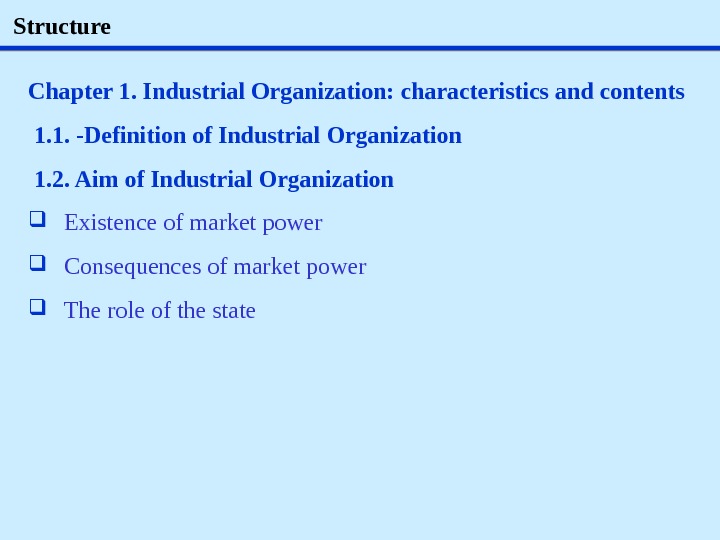
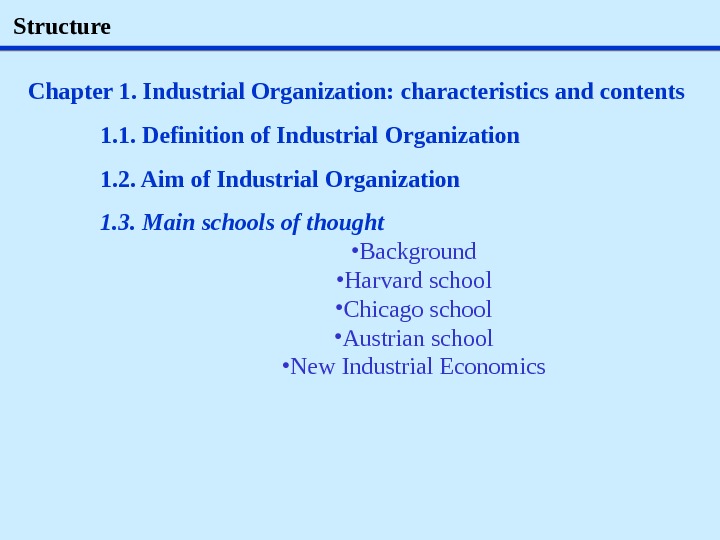
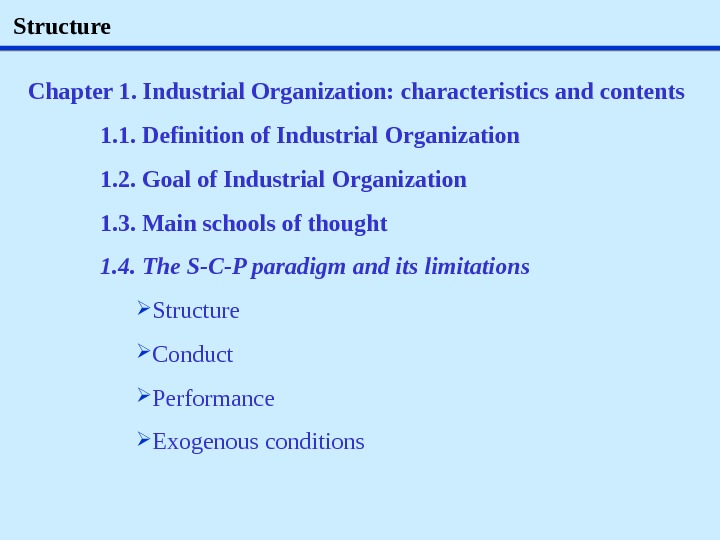
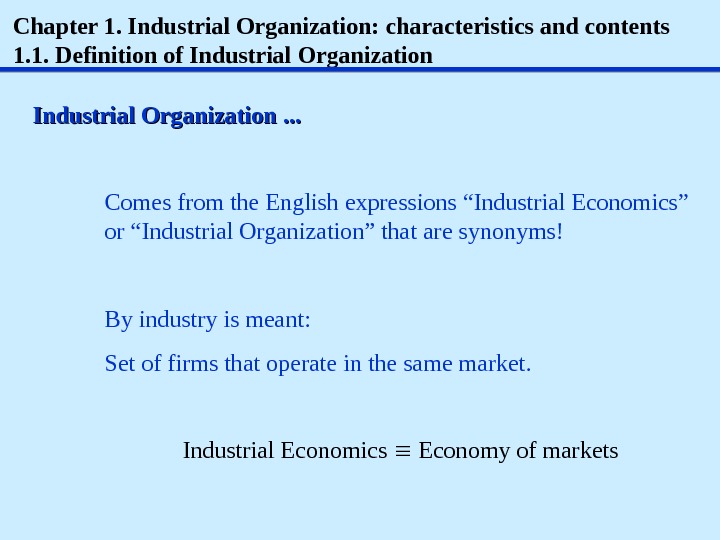
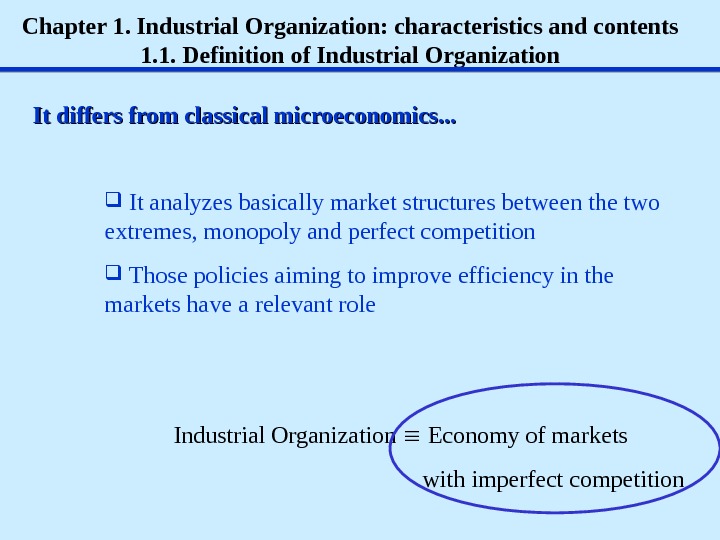
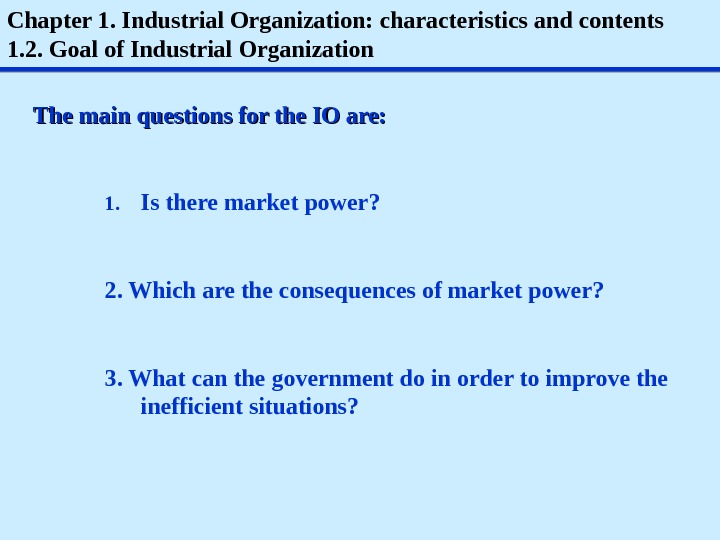

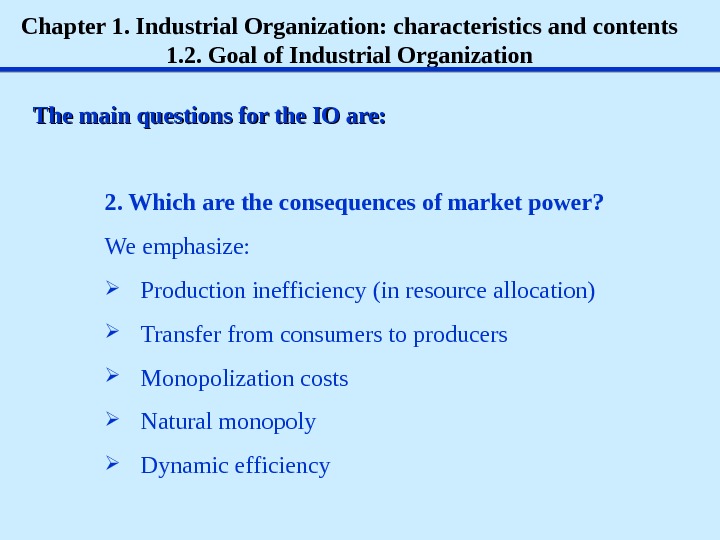
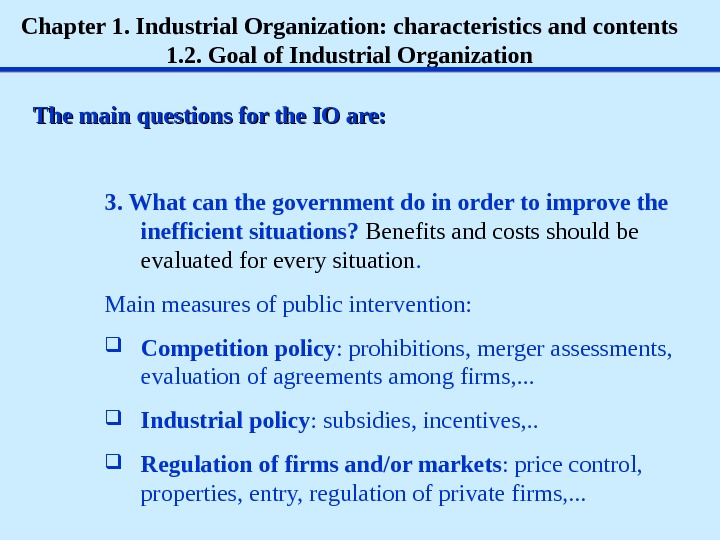
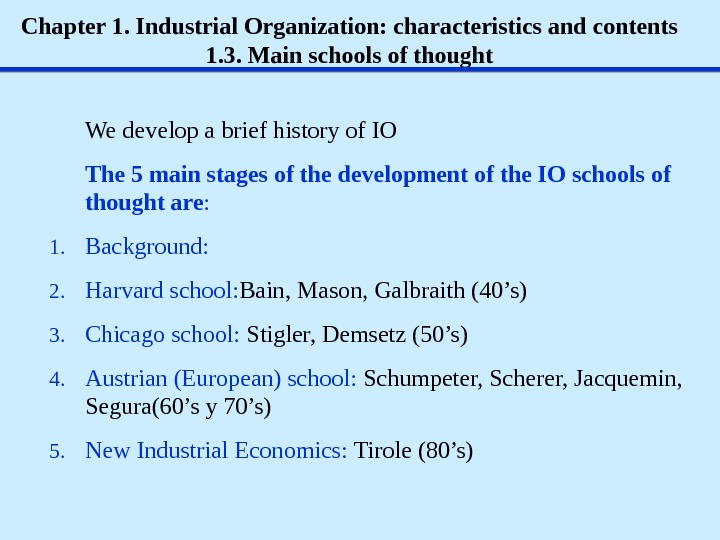
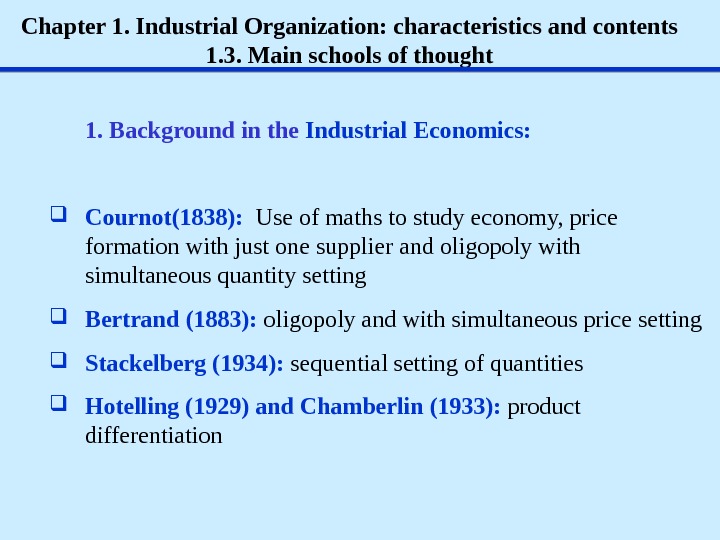
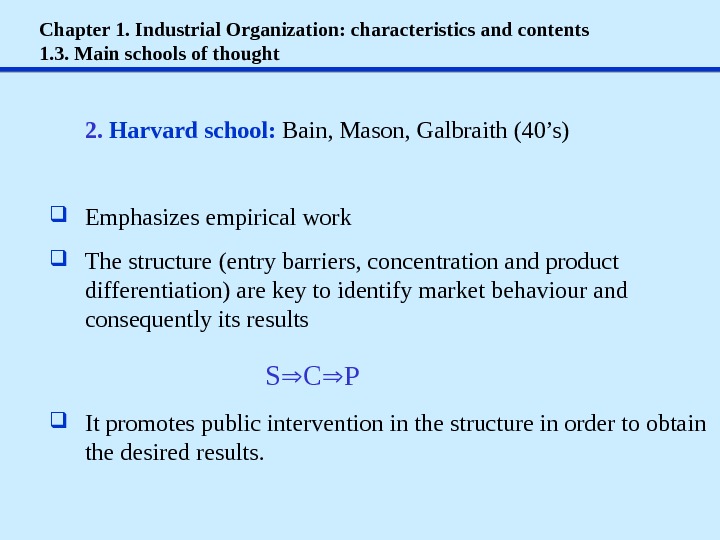
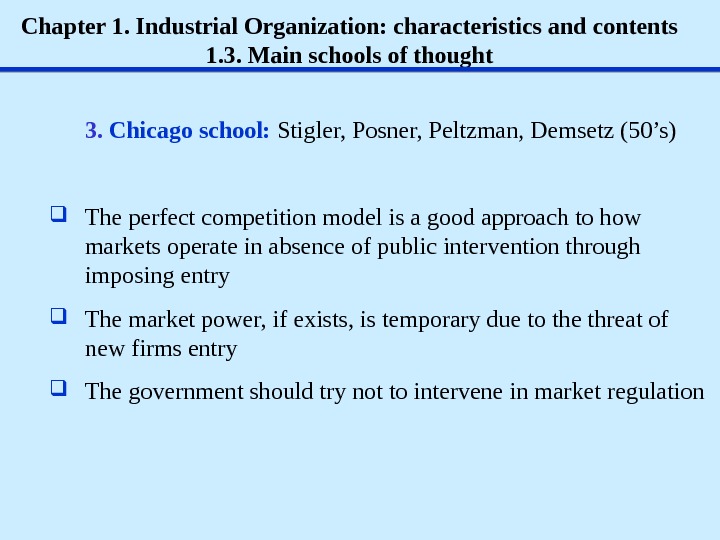
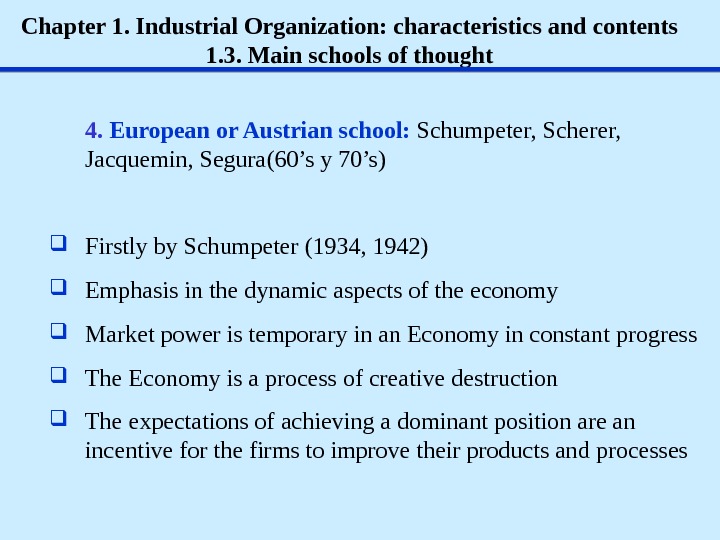
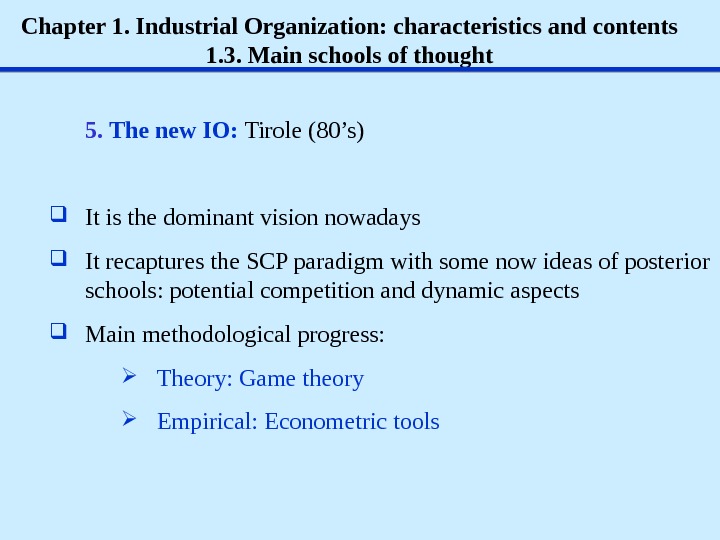
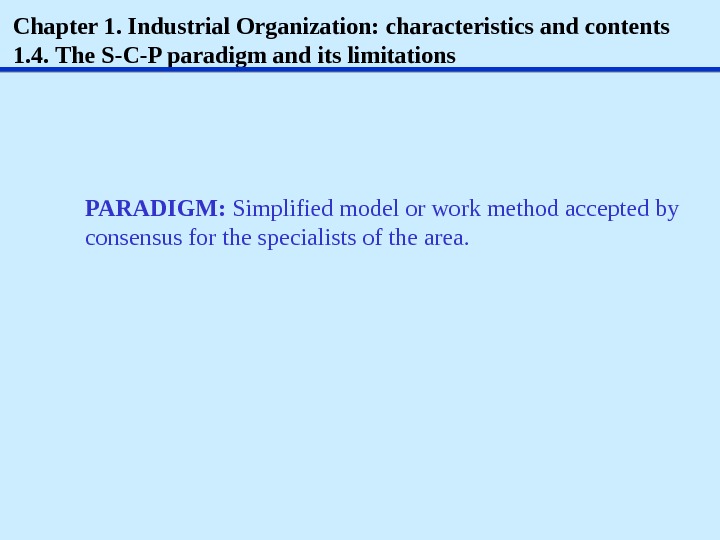
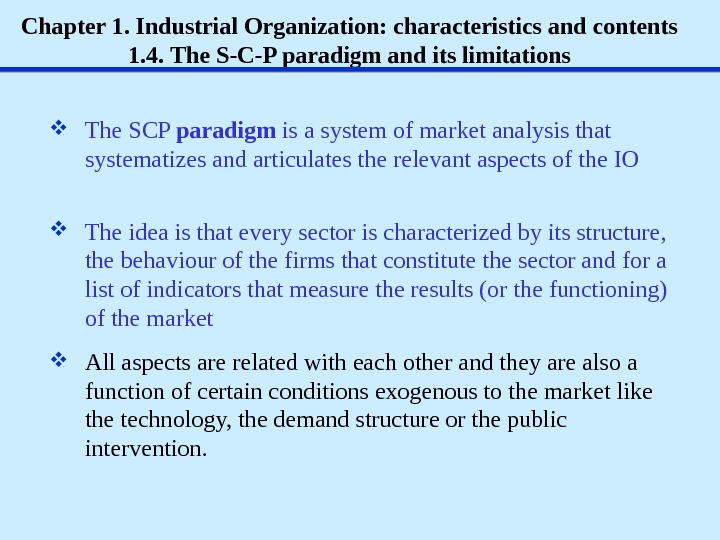
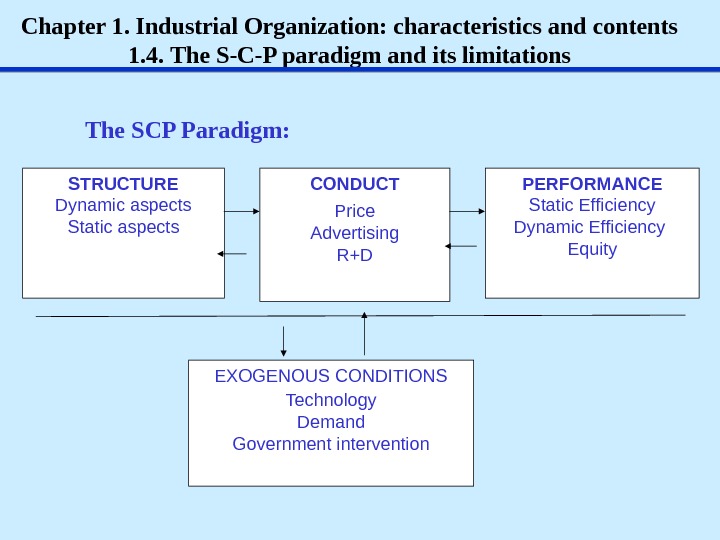
t1.economia_industrial_english.ppt
- Размер: 365 Кб
- Количество слайдов: 27
Описание презентации Industrial Organization: characteristics and contents Marc Escrihuela по слайдам
 Industrial Organization: characteristics and contents Marc Escrihuela Villar February
Industrial Organization: characteristics and contents Marc Escrihuela Villar February
 2 Program Course goals 1) Competitive analysis of firms in markets from both a theoretical and applied perspective. 2) Study of competitive markets and, especially, non-competitive, with special attention to the analysis of decisions under a monopoly and oligopoly context. 3) Understanding the consequences of strategic interdependence of firms in markets. 4) Ability to make applications of theoretical models in order to explain the actual market fundamentals and monitoring of regulation and competition policies that enhance their efficiency.
2 Program Course goals 1) Competitive analysis of firms in markets from both a theoretical and applied perspective. 2) Study of competitive markets and, especially, non-competitive, with special attention to the analysis of decisions under a monopoly and oligopoly context. 3) Understanding the consequences of strategic interdependence of firms in markets. 4) Ability to make applications of theoretical models in order to explain the actual market fundamentals and monitoring of regulation and competition policies that enhance their efficiency.
 3 Program Outline of the Course • Block 1: Introduction to Industrial Organization. • (Ch 1 and Ch 2). • Block 2: The monopoly power. (Ch 3 and Ch 4). • Block 3: The strategic interaction of oligopolies. • (Ch 5 to Ch 9) • Block 4: Competition policy (Ch 10)
3 Program Outline of the Course • Block 1: Introduction to Industrial Organization. • (Ch 1 and Ch 2). • Block 2: The monopoly power. (Ch 3 and Ch 4). • Block 3: The strategic interaction of oligopolies. • (Ch 5 to Ch 9) • Block 4: Competition policy (Ch 10)
 4 Program Syllabus Block 1. Introduction to Industrial Organization Item 1. Industrial Organization: the nature and content Item 2. Market structure Block 2. Monopoly power Item 3. Monopoly Item 4. Price discrimination and product selection Block 3. The strategic interaction of oligopolistic Item 5. Homogeneous product oligopoly 5. 1 Models of static oligopoly 5. 2 Models of dynamic oligopoly Item 6. Oligopoly with product differentiation and advertising Item 7. Barriers to entry Item 8. Mergers and acquisitions Item 9. Technical change. R & D Block 4. Competition policies Item 10. Industrial policy and competition
4 Program Syllabus Block 1. Introduction to Industrial Organization Item 1. Industrial Organization: the nature and content Item 2. Market structure Block 2. Monopoly power Item 3. Monopoly Item 4. Price discrimination and product selection Block 3. The strategic interaction of oligopolistic Item 5. Homogeneous product oligopoly 5. 1 Models of static oligopoly 5. 2 Models of dynamic oligopoly Item 6. Oligopoly with product differentiation and advertising Item 7. Barriers to entry Item 8. Mergers and acquisitions Item 9. Technical change. R & D Block 4. Competition policies Item 10. Industrial policy and competition
 5 Week Chapter Assessment/Events 1 Chapter 1 and 2 2 Chapter 2 3 Chapter 3 4 Chapter 3 and 4 5 Chapter 4 6 Chapter 4 7 Chapter 5 8 Chapter 5 Mid term exam 1 9 Chapter 5 Eastern Holidays 10 Chapter 5. 2 11 Chapter 6 12 Chapter 7 13 Chapter 8 14 Chapter 9 15 Review Mid term exam 2 16 17 -19 Final exam • Indicative Schedule
5 Week Chapter Assessment/Events 1 Chapter 1 and 2 2 Chapter 2 3 Chapter 3 4 Chapter 3 and 4 5 Chapter 4 6 Chapter 4 7 Chapter 5 8 Chapter 5 Mid term exam 1 9 Chapter 5 Eastern Holidays 10 Chapter 5. 2 11 Chapter 6 12 Chapter 7 13 Chapter 8 14 Chapter 9 15 Review Mid term exam 2 16 17 -19 Final exam • Indicative Schedule
 6 Program Basic bibliography — Luis Cabral, «Introduction to Industrial Organization», MIT Press, 2000. — O. Shy, ‘Industrial Organization: Theory and Applications’, MIT Press, 1998. — Luís Cabral, ‘Economía Industrial’, Mc. Graw Hill, 1997. — H. Varian, ‘Introduction to Microeconomics’. Ed. Antoni Bosch. . Other bibliography Prácticas de las asignaturas de Economía y Organización Industrial, Material Didàctic 153, UIB 2012. Marc Escrihuela, Maria Sard Bauzà, Maria Tugores Ques.
6 Program Basic bibliography — Luis Cabral, «Introduction to Industrial Organization», MIT Press, 2000. — O. Shy, ‘Industrial Organization: Theory and Applications’, MIT Press, 1998. — Luís Cabral, ‘Economía Industrial’, Mc. Graw Hill, 1997. — H. Varian, ‘Introduction to Microeconomics’. Ed. Antoni Bosch. . Other bibliography Prácticas de las asignaturas de Economía y Organización Industrial, Material Didàctic 153, UIB 2012. Marc Escrihuela, Maria Sard Bauzà, Maria Tugores Ques.
 7 Program Continuous assessment a) Test 1: midterm exam (25%) at the end of chapter 5. 1 (aprox. ) (NR) b) Test 2: mid-term exam (25%), in the last lecture of the semester (NR) c) 1 final exam (50%) including the whole course. (R)
7 Program Continuous assessment a) Test 1: midterm exam (25%) at the end of chapter 5. 1 (aprox. ) (NR) b) Test 2: mid-term exam (25%), in the last lecture of the semester (NR) c) 1 final exam (50%) including the whole course. (R)
 Placement INDUSTRIAL ORGANIZATION Firstpart: Introduction Chapter 1. Industrial. Organization: characteristicsandcontents 1. 1. Definitionof. Industrial. Organization 1. 2. Aimof. Industrial. Organization 1. 3. Mainschoolsofthought 1. 4. The. SCRparadigmanditslimitations Chapter 2. The. Structureofthemarkets Chapter 3. The. Monopoly
Placement INDUSTRIAL ORGANIZATION Firstpart: Introduction Chapter 1. Industrial. Organization: characteristicsandcontents 1. 1. Definitionof. Industrial. Organization 1. 2. Aimof. Industrial. Organization 1. 3. Mainschoolsofthought 1. 4. The. SCRparadigmanditslimitations Chapter 2. The. Structureofthemarkets Chapter 3. The. Monopoly
 Structure Chapter 1. Industrial Organization: characteristics and contents 1. 1. — Definition of Industrial Organization Relationship with microeconomics Differentiated discipline
Structure Chapter 1. Industrial Organization: characteristics and contents 1. 1. — Definition of Industrial Organization Relationship with microeconomics Differentiated discipline
 Structure Chapter 1. Industrial Organization: characteristics and contents 1. 1. -Definition of Industrial Organization 1. 2. Aim of Industrial Organization Existence of market power Consequences of market power The role of the state
Structure Chapter 1. Industrial Organization: characteristics and contents 1. 1. -Definition of Industrial Organization 1. 2. Aim of Industrial Organization Existence of market power Consequences of market power The role of the state
 Structure Chapter 1. Industrial Organization: characteristics and contents 1. 1. Definition of Industrial Organization 1. 2. Aim of Industrial Organization 1. 3. Main schools of thought • Background • Harvard school • Chicago school • Austrian school • New Industrial Economics
Structure Chapter 1. Industrial Organization: characteristics and contents 1. 1. Definition of Industrial Organization 1. 2. Aim of Industrial Organization 1. 3. Main schools of thought • Background • Harvard school • Chicago school • Austrian school • New Industrial Economics
 Structure Chapter 1. Industrial Organization: characteristics and contents 1. 1. Definition of Industrial Organization 1. 2. Goal of Industrial Organization 1. 3. Main schools of thought 1. 4. The S-C-P paradigm and its limitations Structure Conduct Performance Exogenous conditions
Structure Chapter 1. Industrial Organization: characteristics and contents 1. 1. Definition of Industrial Organization 1. 2. Goal of Industrial Organization 1. 3. Main schools of thought 1. 4. The S-C-P paradigm and its limitations Structure Conduct Performance Exogenous conditions
 Chapter 1. Industrial Organization: characteristics and contents 1. 1. Definition of Industrial Organization. . . Comes from the English expressions “Industrial Economics” or “Industrial Organization” that are synonyms! By industry is meant: Set of firms that operate in the same market. Industrial Economics Economy of markets
Chapter 1. Industrial Organization: characteristics and contents 1. 1. Definition of Industrial Organization. . . Comes from the English expressions “Industrial Economics” or “Industrial Organization” that are synonyms! By industry is meant: Set of firms that operate in the same market. Industrial Economics Economy of markets
 Chapter 1. Industrial Organization: characteristics and contents 1. 1. Definition of Industrial Organization It differs from classical microeconomics. . . It analyzes basically market structures between the two extremes, monopoly and perfect competition Those policies aiming to improve efficiency in the markets have a relevant role Industrial Organization Economy of markets with imperfect competition
Chapter 1. Industrial Organization: characteristics and contents 1. 1. Definition of Industrial Organization It differs from classical microeconomics. . . It analyzes basically market structures between the two extremes, monopoly and perfect competition Those policies aiming to improve efficiency in the markets have a relevant role Industrial Organization Economy of markets with imperfect competition
 Chapter 1. Industrial Organization: characteristics and contents 1. 2. Goal of Industrial Organization The main questions for the IO are: 1. Is there market power? 2. Which are the consequences of market power? 3. What can the government do in order to improve the inefficient situations?
Chapter 1. Industrial Organization: characteristics and contents 1. 2. Goal of Industrial Organization The main questions for the IO are: 1. Is there market power? 2. Which are the consequences of market power? 3. What can the government do in order to improve the inefficient situations?
 Chapter 1. Industrial Organization: characteristics and contents 1. 2. Goal of Industrial Organization The main questions for the IO are: 1. Is there market power? The first welfare theorem says that in absence of market power we have an efficient allocation An approach to the loss of efficiency caused by market power consists of analyzing the difference between price and marginal cost.
Chapter 1. Industrial Organization: characteristics and contents 1. 2. Goal of Industrial Organization The main questions for the IO are: 1. Is there market power? The first welfare theorem says that in absence of market power we have an efficient allocation An approach to the loss of efficiency caused by market power consists of analyzing the difference between price and marginal cost.
 Chapter 1. Industrial Organization: characteristics and contents 1. 2. Goal of Industrial Organization The main questions for the IO are: 2. Which are the consequences of market power? We emphasize: Production inefficiency (in resource allocation) Transfer from consumers to producers Monopolization costs Natural monopoly Dynamic efficiency
Chapter 1. Industrial Organization: characteristics and contents 1. 2. Goal of Industrial Organization The main questions for the IO are: 2. Which are the consequences of market power? We emphasize: Production inefficiency (in resource allocation) Transfer from consumers to producers Monopolization costs Natural monopoly Dynamic efficiency
 Chapter 1. Industrial Organization: characteristics and contents 1. 2. Goal of Industrial Organization The main questions for the IO are: 3. What can the government do in order to improve the inefficient situations? Benefits and costs should be evaluated for every situation. Main measures of public intervention: Competition policy : prohibitions, merger assessments, evaluation of agreements among firms, . . . Industrial policy : subsidies, incentives, . . Regulation of firms and/or markets : price control, properties, entry, regulation of private firms, . . .
Chapter 1. Industrial Organization: characteristics and contents 1. 2. Goal of Industrial Organization The main questions for the IO are: 3. What can the government do in order to improve the inefficient situations? Benefits and costs should be evaluated for every situation. Main measures of public intervention: Competition policy : prohibitions, merger assessments, evaluation of agreements among firms, . . . Industrial policy : subsidies, incentives, . . Regulation of firms and/or markets : price control, properties, entry, regulation of private firms, . . .
 Chapter 1. Industrial Organization: characteristics and contents 1. 3. Main schools of thought We develop a brief history of IO The 5 main stages of the development of the IO schools of thought are : 1. Background: 2. Harvard school: Bain, Mason, Galbraith (40’s) 3. Chicago school: Stigler, Demsetz (50’s) 4. Austrian (European) school: Schumpeter, Scherer, Jacquemin, Segura(60’s y 70’s) 5. New Industrial Economics: Tirole (80’s)
Chapter 1. Industrial Organization: characteristics and contents 1. 3. Main schools of thought We develop a brief history of IO The 5 main stages of the development of the IO schools of thought are : 1. Background: 2. Harvard school: Bain, Mason, Galbraith (40’s) 3. Chicago school: Stigler, Demsetz (50’s) 4. Austrian (European) school: Schumpeter, Scherer, Jacquemin, Segura(60’s y 70’s) 5. New Industrial Economics: Tirole (80’s)
 Chapter 1. Industrial Organization: characteristics and contents 1. 3. Main schools of thought 1. Background in the Industrial Economics: Cournot(1838): Use of maths to study economy, price formation with just one supplier and oligopoly with simultaneous quantity setting Bertrand (1883): oligopoly and with simultaneous price setting Stackelberg (1934): sequential setting of quantities Hotelling (1929) and Chamberlin (1933): product differentiation
Chapter 1. Industrial Organization: characteristics and contents 1. 3. Main schools of thought 1. Background in the Industrial Economics: Cournot(1838): Use of maths to study economy, price formation with just one supplier and oligopoly with simultaneous quantity setting Bertrand (1883): oligopoly and with simultaneous price setting Stackelberg (1934): sequential setting of quantities Hotelling (1929) and Chamberlin (1933): product differentiation
 Chapter 1. Industrial Organization: characteristics and contents 1. 3. Main schools of thought 2. Harvard school: Bain, Mason, Galbraith (40’s) Emphasizes empirical work The structure (entry barriers, concentration and product differentiation) are key to identify market behaviour and consequently its results S C P It promotes public intervention in the structure in order to obtain the desired results.
Chapter 1. Industrial Organization: characteristics and contents 1. 3. Main schools of thought 2. Harvard school: Bain, Mason, Galbraith (40’s) Emphasizes empirical work The structure (entry barriers, concentration and product differentiation) are key to identify market behaviour and consequently its results S C P It promotes public intervention in the structure in order to obtain the desired results.
 Chapter 1. Industrial Organization: characteristics and contents 1. 3. Main schools of thought 3. Chicago school: Stigler, Posner, Peltzman, Demsetz (50’s) The perfect competition model is a good approach to how markets operate in absence of public intervention through imposing entry The market power, if exists, is temporary due to the threat of new firms entry The government should try not to intervene in market regulation
Chapter 1. Industrial Organization: characteristics and contents 1. 3. Main schools of thought 3. Chicago school: Stigler, Posner, Peltzman, Demsetz (50’s) The perfect competition model is a good approach to how markets operate in absence of public intervention through imposing entry The market power, if exists, is temporary due to the threat of new firms entry The government should try not to intervene in market regulation
 Chapter 1. Industrial Organization: characteristics and contents 1. 3. Main schools of thought 4. European or Austrian school: Schumpeter, Scherer, Jacquemin, Segura(60’s y 70’s) Firstly by Schumpeter (1934, 1942) Emphasis in the dynamic aspects of the economy Market power is temporary in an Economy in constant progress The Economy is a process of creative destruction The expectations of achieving a dominant position are an incentive for the firms to improve their products and processes
Chapter 1. Industrial Organization: characteristics and contents 1. 3. Main schools of thought 4. European or Austrian school: Schumpeter, Scherer, Jacquemin, Segura(60’s y 70’s) Firstly by Schumpeter (1934, 1942) Emphasis in the dynamic aspects of the economy Market power is temporary in an Economy in constant progress The Economy is a process of creative destruction The expectations of achieving a dominant position are an incentive for the firms to improve their products and processes
 Chapter 1. Industrial Organization: characteristics and contents 1. 3. Main schools of thought 5. The new IO: Tirole (80’s) It is the dominant vision nowadays It recaptures the SCP paradigm with some now ideas of posterior schools: potential competition and dynamic aspects Main methodological progress: Theory: Game theory Empirical: Econometric tools
Chapter 1. Industrial Organization: characteristics and contents 1. 3. Main schools of thought 5. The new IO: Tirole (80’s) It is the dominant vision nowadays It recaptures the SCP paradigm with some now ideas of posterior schools: potential competition and dynamic aspects Main methodological progress: Theory: Game theory Empirical: Econometric tools
 Chapter 1. Industrial Organization: characteristics and contents 1. 4. The S-C-P paradigm and its limitations PARADIGM: Simplified model or work method accepted by consensus for the specialists of the area.
Chapter 1. Industrial Organization: characteristics and contents 1. 4. The S-C-P paradigm and its limitations PARADIGM: Simplified model or work method accepted by consensus for the specialists of the area.
 Chapter 1. Industrial Organization: characteristics and contents 1. 4. The S-C-P paradigm and its limitations The SCP paradigm is a system of market analysis that systematizes and articulates the relevant aspects of the IO The idea is that every sector is characterized by its structure, the behaviour of the firms that constitute the sector and for a list of indicators that measure the results (or the functioning) of the market All aspects are related with each other and they are also a function of certain conditions exogenous to the market like the technology, the demand structure or the public intervention.
Chapter 1. Industrial Organization: characteristics and contents 1. 4. The S-C-P paradigm and its limitations The SCP paradigm is a system of market analysis that systematizes and articulates the relevant aspects of the IO The idea is that every sector is characterized by its structure, the behaviour of the firms that constitute the sector and for a list of indicators that measure the results (or the functioning) of the market All aspects are related with each other and they are also a function of certain conditions exogenous to the market like the technology, the demand structure or the public intervention.
 Chapter 1. Industrial Organization: characteristics and contents 1. 4. The S-C-P paradigm and its limitations The SCP Paradigm : STRUCTURE Dynamic aspects Static aspects CONDUCT Price Advertising R+D PERFORMANCE Static Efficiency Dynamic Efficiency Equity EXOGENOUS CONDITIONS Technology Demand Government intervention
Chapter 1. Industrial Organization: characteristics and contents 1. 4. The S-C-P paradigm and its limitations The SCP Paradigm : STRUCTURE Dynamic aspects Static aspects CONDUCT Price Advertising R+D PERFORMANCE Static Efficiency Dynamic Efficiency Equity EXOGENOUS CONDITIONS Technology Demand Government intervention

